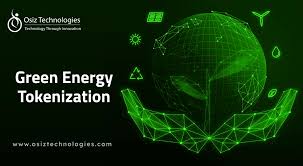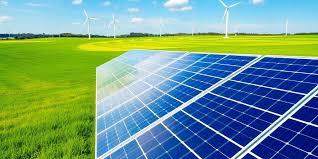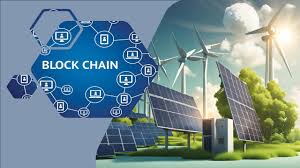In 2025, a quiet revolution is humming beneath the surface of our power grids. It’s not just about cleaner energy anymore — it’s about ownership, access, and trust. The fusion of blockchain technology and renewable energy is rewriting the rules of how power is produced, funded, and shared. What once belonged to sprawling corporations and government-backed utilities is, at last, being placed into the hands of everyday people.
This isn’t a futuristic fantasy. It’s happening right now — through tokenisation, the process of transforming real-world energy assets into digital tokens that anyone can own, trade, or invest in.

From Solar Panels to Digital Tokens
Imagine you could own a piece of a solar farm hundreds of miles away. Not a symbolic piece — a real fraction that earns you a share of its clean energy output. That’s tokenisation in action.
Here’s how it works: renewable energy assets — like wind turbines or solar installations — are digitally represented on a blockchain. Each token equals a slice of ownership or entitlement to the energy produced. Smart contracts manage everything automatically: how much power is generated, who gets paid, and when.
Renewable Energy Certificates (RECs), which prove that a megawatt-hour of green energy has been produced, are now being converted into blockchain tokens too. This makes trading faster, cleaner, and transparent — no more confusing middlemen or lost paperwork.
It’s a way to make something invisible — electrons flowing through wires — tangible, tradable, and trustworthy.
Why Now? The Perfect Storm of 2025
There’s a reason this movement is gaining momentum now.
First, the climate clock is ticking. Governments and corporations are racing to cut emissions, but traditional financing can’t keep up with the scale of the renewable buildout we need. Tokenisation offers a way for the crowd — not just the elite — to participate in funding the energy transition.
Second, the tech is finally ready. Blockchains are faster, smarter, and cheaper than they were five years ago. Smart contracts can now handle complex real-world rules with minimal friction. In June 2025, energy giant Enel launched a project on the Algorand blockchain, letting ordinary people invest in renewable assets via digital tokens — a glimpse of what’s to come.
And third, people want a say. Energy has always felt distant — controlled by utilities, politicians, or faceless corporations. Tokenisation flips that script. Suddenly, you don’t just consume electricity; you own a piece of the system that powers your world.

Real-World Applications: The New Energy Economy
So what does this look like in practice? Quite a few things are already in motion:
-
- Fractional ownership of solar or wind projects. Imagine receiving dividends each month from the sun’s rays.
-
- Peer-to-peer energy trading in microgrids. Households with rooftop panels can sell excess power directly to neighbors — no utility required.
-
- Tokenised carbon credits and RECs. Blockchain makes sure every certificate is authentic, traceable, and impossible to double-count.
-
- Community-driven green financing. Developers can raise funds for new energy projects through token sales instead of banks, empowering local participation.
Each of these models shares a common thread — decentralisation. It’s about bringing energy closer to the people who use it and letting them share in its rewards.
The Problems It Solves — And Why It Feels So Urgent
Let’s be honest: the traditional energy system is broken in more ways than one.
Projects are slow, bureaucratic, and expensive. Ordinary citizens rarely get the chance to invest. Markets for renewable certificates are murky and confusing. And once you do get involved, selling or transferring ownership is a nightmare.
Blockchain solves these pain points with ruthless efficiency. It’s transparent. It’s traceable. It removes the friction that’s long made renewable energy feel exclusive and out of reach.
With tokenisation, anyone can buy a slice of a solar park or wind farm. Anyone can see — in real time — where their money goes, what energy it’s generating, and how it’s helping the planet.
That’s powerful.
The Hard Truth: Challenges Still Loom
Of course, it’s not all sunshine and smart contracts. The road ahead is messy — as every revolution is.
Regulation remains the biggest question mark. Who governs these tokens? Are they securities? Commodities? Energy credits? Many countries still don’t have clear answers.
Verification is another issue. Tokens only have value if the energy data behind them is accurate. That means integrating sensors, IoT devices, and smart meters seamlessly into blockchain systems — a tough technical challenge.
And yes, standardisation matters. Without common frameworks, each project risks becoming an island, incompatible with the rest of the world’s energy markets.
There’s also a risk of greenwashing — companies tokenising vague “renewable” claims without real substance behind them. Transparency helps, but oversight must evolve alongside innovation.
Looking Ahead: The Power Grid of the Future
Fast forward a few years. A family in Madrid owns ten tokens representing a nearby solar farm. Their monthly energy bill? Lower — thanks to dividends from those tokens. In Berlin, a neighborhood microgrid lets residents sell power from their balconies to one another. Across the Atlantic, corporations offset emissions by trading verified, tokenised renewable certificates on transparent global exchanges.
This isn’t science fiction. It’s the logical next step of a world that’s tired of waiting for someone else to fix the energy problem.
By 2030, analysts predict that tokenised energy assets could form a market worth trillions. And maybe, just maybe, that means the grid will belong to everyone — not just those who can afford to build it.

A Final Thought
The marriage of blockchain and renewable energy isn’t just a technical evolution. It’s a cultural one — about trust, collaboration, and the democratization of power in every sense of the word.
The vision is ambitious: a transparent, community-driven energy ecosystem where ownership is shared, profits are fair, and sustainability isn’t a slogan but a lived reality.
Will it be easy? Not at all. But neither was the first solar panel.
If 2025 is the year the world starts tokenising its energy, it might also be the year we start humanising it — giving everyone, everywhere, a genuine stake in the light that powers our lives.
Curious about crypto mining sustainability? Check